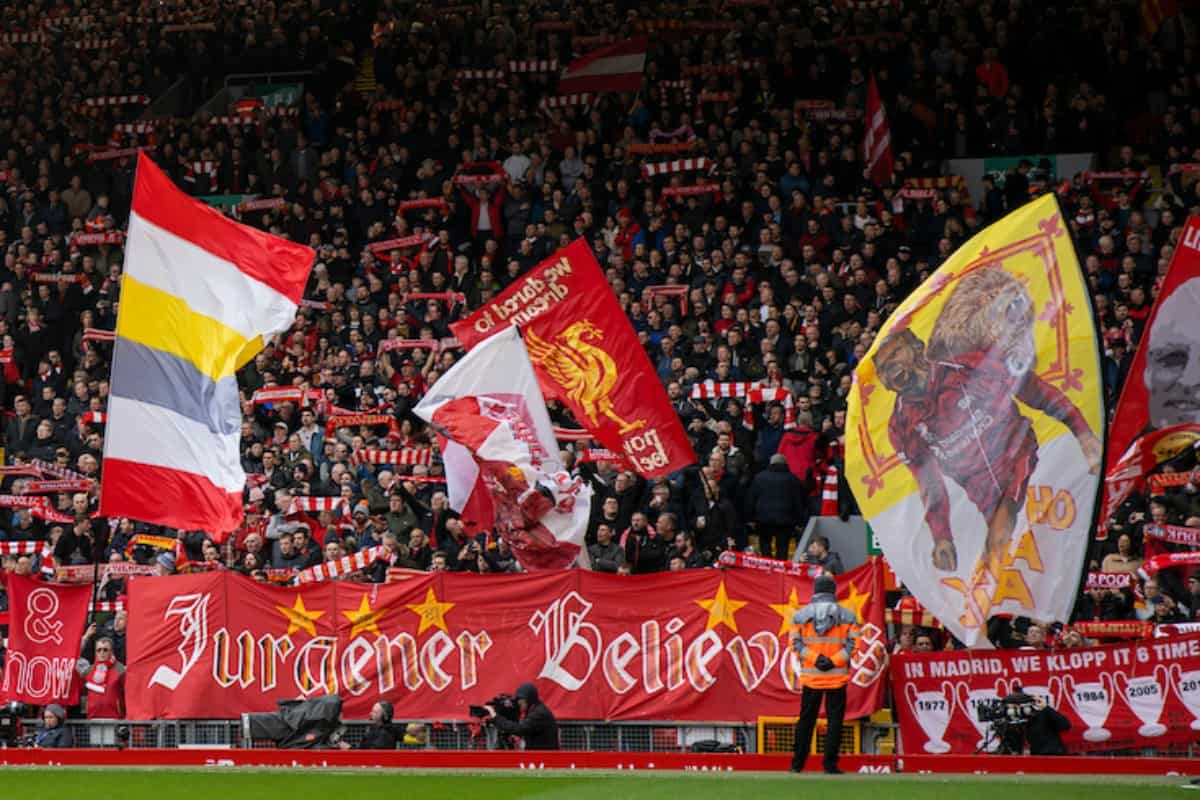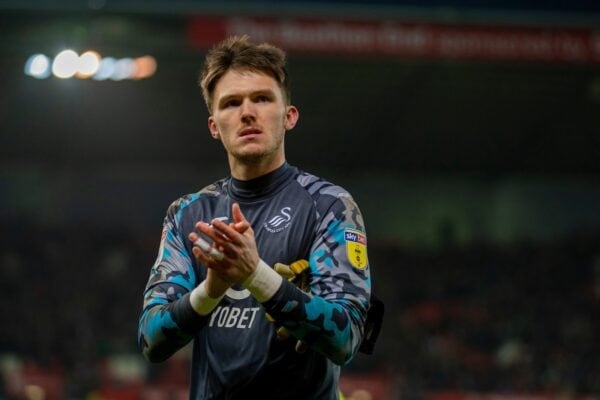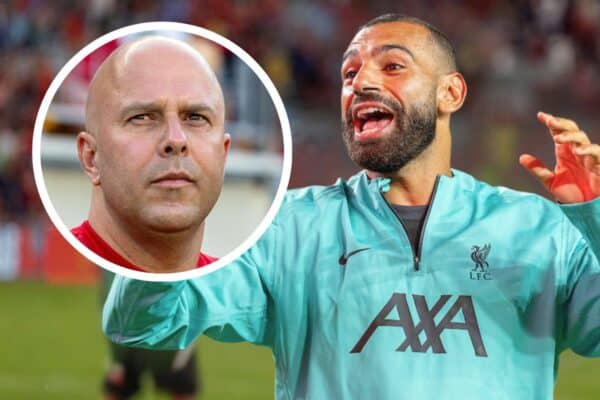
Anfield.
The name alone conjures up an image of inspiration for every Liverpool fan and evokes memories of legendary afternoons and evenings for football supporters the world over. The place is steeped in history. It’s trophy room has been the residence of the League Championship trophy on no less than nineteen occasions. Yes, nineteen. That is neither a misprint nor an error by the author, as the first of those Championship campaigns came when Everton’s name was above the home dressing room door, two years before the well-documented rent dispute which led to John Houlding forming Liverpool Football club. (by the way, the home dressing room in those early days was not at the Anfield ground at all, instead the players had to change at the nearby Sandon pub and would walk across to the ground prior to kick-off).
From the evolution of the mighty Spion Kop, the addition of the vast roof to the terrace in 1928, the Billy Liddell era, the magical sixties under Shankly and famous nights against Inter Milan, St Ettiene, Bruges, Chelsea, arsenal, Barcelona, countless derby day memories etc to the moving tributes to the victims of April 15th 1989, football’s most famous venue has seen just about everything.
When David Moores and Rick Parry decided upon the ill-fated sale of the club to Tom Hocks and George Gillett in 2007, it was because Mr Moores did not have the necessary funds to move Liverpool FC up to the level at which it could compete with Manchester United, insofar as the Anfield capacity was inadequately short of that required.
Enter the new US owners. At their inaugural press conference in February 2007, Gillett confirmed their commitment to abandon the current site and build the proposed New Anfield stadium in nearby Stanley park. “The shovel needs to be in the ground in the next 60 days” he stated clearly. “We are fully supportive of the Stanley park development and of building a facility that we hope will be the greatest facility in this sport”.
This grandiose statement was sadly to prove to be typically wide of the mark and by the end of 2010 the hapless owners had been forcibly removed by a combination of fan-power and foreclosure by the lending banks.
And so to the present. NESV (now FSG) are in control and to the relief of Liverpool’s vast army of followers they have thus far proved to be a model of low-key discretion.
There have been no wild claims, no shotgun announcements; just measured statements more in keeping with the fabled ‘Liverpool Way’.
So where does all this leave Liverpool FC and their stadium dilemma? Earlier this week new Liverpool chairman gave his first series of media interviews in which he confirmed that no decision has yet been finalised over the stadium issue. Tellingly, he did confirm that the current ground is “not fit for purpose” and that Manchester United had “zoomed past us” in the area of matchday revenue.
So how do LFC narrow the gap in generation of matchday revenues?
Basically there are three options on the table (well, two in reality)
– Redevelop current site
– Groundshare with Everton FC (Stanley Park site)
– Relocate to new site in Stanley Park
Let me first of all rule out the second (groundshare) option.
There will be no groundshare, in spite of Everton’s obvious leaning towards it and the regular revisitation of the topic by certain prominent members of the Council and local community. Given EFC’s parlous financial state a shared ground would have to be built and owned by Liverpool with the Blues being tenants. (An ironic proposition, given the circumstances of LFC’s formation in 1892). One end of the stadium would invariably become known as ‘their end’ and there are far too may Liverpool supporters who would simply refuse to occupy those seats during the Reds’ home matches.
So having ruled out the groundshare option, it becomes a straight choice – RELOCATE or REDEVELOP.

Capacity / land constraints
By redeveloping the current Anfield stadium the increased capacity would be limited to the amount of additional footprint available. Both the Kop and Centenary Stands are of a reasonable size and it would be safe to assume that initial development of the Main Stand and Anfield Road End would be high on the agenda. The Main Stand has a small car park area to the rear with terraced houses beyond. However most of the properties in Lothair Road adjoining this side of the stadium are unoccupied and the club has purchased most, if not all of them. (There would be estate issues to be resolved if any were still in private ownership).
Historically the ground has been constrained on it’s north east side by Anfield Road, and when the second tier was added in the 90s the issues of right-to-light was a major stumbling block and curtailed the club’s proposals. Since the planning approval for the new site in Stanley park was granted, however, the properties on Anfield Road directly opposite the stadium have been demolished and cleared to facilitate the proposed Anfield Plaza. (Luckily the first property to escape the bulldozers on the Arkles side of the ground is no73 Anfield Road. A grand property which was the John Houlding’shome and where he held the meeting on 15th March 1892 which resulted in the agreement to form Liverpool Football Club.)
This site clearance work for the new stadium has paradoxically opened up the possibilities for redevelopment. The fact that there is now space between the Anfield Road End makes it possible to extend in that direction. A new stand equal in size to the Kop could now be accommodated. What about Anfield Road itself?
If permission could not be gained to realign Anfield Road so that it is diverted some 30 metres or so into the park then a new stand could span across the road so that the traffic passes through via an underpass. Of course during construction the road would need to be closed anyway for up to a year so in my opinion the option of constructing a diverted thoroughfare as an advanced works phase would be the preferred option.
I estimate initial redevelopment of Centenary and Main Stands as above would enable an increased capacity of up to around 60,000 as a minimum.
The footprint of the approved site in Stanley Park between Mill Lane (path bisecting the main field) and Arkles Lane is of sufficient area to accommodate a stadium of any size up to 90,000.


Corporate Facilities
One of the major issues restricting revenues at Anfield is the inadequate corporate facilities. The new stadium proposal includes tiers of boxes and corporate floors as all new stadiums, with the exception of one end which would be a vast bank of spectators uninterrupted by corporate boxes, in order to duplicate the array of passionate humanity in keeping with the traditions of the famous Kop.
As described above redevelopment of Main Stand /Anfield Road stand could equally accommodate corporate facilities thus addressing the shortfall in the same manner as the new stadium would.
It is unlikely in the extreme that Liverpool will ever generate as much via corporate income as the likes of Chelsea, Arsenal or Tottenham, by nature of the simple fact that the economy in the northwest does not have firms of Investment Bankers or Financial Institutions like the capital. Without patronising it is unreasonable to expect even the most successful Merseyside firms to spend as much on corporate hospitality as their more affluent peers from the south-east.
Programming the Construction
One area in which the new stadium holds the advantages is in programming construction to minimise short-term disruption in revenues. The planning issues are resolved and construction of the new arena could be carried out in its entirety without any effect whilst fixtures are played at the exisiting site.
Redevelopment would inevitably mean that capacity is reduced in the short term. I recall when the Main Stand was constructed in the early 1970’s it was done in three phases and rather than closing one side of the stadium at least one third of that side was always in use to some extent. Nevertheless the cost implications of this would have to be factored in to any decision. Possibly, if diversion of Anfield Road could be agreed, it would be possible to construct behind the existing Annie Rd end throughout the football season with the demolition of the existing stand and subsequent construction of new front section of the new stand undertaken during close season and into the early part of the following season. By doing this a huge stand could be populated, which would then minimise the effects of losing the Main Stand for a year or so.

See also: The case for redevelopment
Tradition
I listed at the start of this piece a just a few of the memorable occasions which Liverpool fans have held dear. Add to that the personal memories such as first visit, first derby match etc and it is understandable why many fans are reluctant in the extreme to countenance demolition of their ‘home’. Let’s not forget the countless times that supporters ashes have been scattered in the Kop goalmouth or on the terrace itself over the decades. No matter how much thought is put into the new design, the risk of losing something treasured lingers.
In the sixties some bright spark on Liverpool City Council gave approval to demolish the famous Cavern Club on Matthew Street made famous by the Beatles. Of course the Cavern Club still attracts thousands of tourists every year, but those tourists have to make do with a replica Cavern Club which has since been built across the road, once the mistake was discovered. If Liverpool FC demolish Anfield, they will no doubt have a superb stadium but if it loses it’s magic they will not have the option of rebuilding a replica of the original in the way of the Cavern.
Aesthetics
Undoubtedly any new stadium in the park would be a sleek state-of-the-art work of beauty, and in this regard this option holds sway. However, as ugly as some may consider the current ground, in my eyes I consider it the most beautiful building in Britain. Seriously. I know it may be a bit of a hotch-potch of styles but whenever I approach it, it inspires me as much as St Paul’s Cathedral or Westminster Abbey. And let’s face it, no matter what the outside appearance of any stadium once inside the focus is firmly on the rectangle of luscious green turf. Football supporters go to the match for the experience. The atmosphere. Without that they may as well stay at home and watch it in comfort on their 50 inch HD or 3D television.
SUMMARY
So, in summary, it is clear that there are so many factors and considerations to take into account for Fenway Sports Group and the new Liverpool Board of Directors that it is understandable that they are taking ample time and surely receiving expert advice before announcing their decision. There is no obvious correct decision, each option having advantages in different areas. Luckily for them, unlike recent decisions over the manager’s position and incoming transfers the supporters are showing patience over the issue, and I suspect that not many are feverishly checking their twitter updates for the latest stadium news.
Hopefully I have outlined the advantages and disadvantages of both options, and although I started out writing with what I thought was an open mind, during the course of composing this blog you have probably gathered that I have come down marginally on the side of the Redevelopment option.
Follow me on twitter at @briandurand56

















Fan Comments